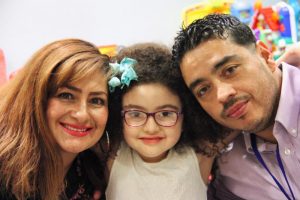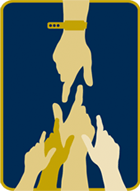by Aubrey Rumore
Amber, 8, has no problem making her way through the long, wide hallways of the hospital. There’s a cape-like cover draped over the back of her walker embroidered with the bold nickname, “SUPER GIRL.” At every turn, the gregarious, Super Girl Amber is greeted by hugs and hellos.
At the age of three, Amber was walking and running, like any kid her age. But around the time she turned four, her parents, Leticia and Miguel, from San Jose, CA, noticed their daughter falling. Their concerns grew as the falls became more frequent.

Amber, 8, Leticia, and Miguel, her parents, San Jose, CA
“We knew something wasn’t right,” Miguel, said, so they took her to the doctor, who concluded Amber might be pigeon-toed or bow-legged. “He said, ‘don’t worry – she’s going to grow out of it.’’ But a year went by and the condition worsened. Leticia and Miguel knew they needed the help of specialists.
After consultations with orthopedists and foot specialists, a neurologist was the first doctor to conduct blood tests on Amber. “It was the morning of Dec. 14, 2015,” Leticia said, that the then 5-year-old Amber was diagnosed with GAN – Giant Axonal Neuropathy – a rare neurogenetic disorder seen in children before the age of five.
Dr. Carsten Bonnemann, a senior investigator at the Neuromuscular and Neurogenetic Disorders of Childhood section, in the National Institute of Neurological Disorders and Stroke (NINDS), explained GAN is a very rare neurodegenerative disease. Dr. Bonnemann and his team have been seeing Amber since her arrival at the NIH. “Children with this disease initially lose the ability to sense their joints; lose balance; then lose motor control over time. It is relentlessly progressive,” he added.
GAN is caused by a defective gene. Dr. Bonnemann says there is no treatment for the disease – yet. Amber is the tenth participant enrolled in a unique research study, a “first in human trial,” that is attempting to replace the defective gene with a good one, placing it into the nerve cells where it’s action is now missing, so it can “take care of the job that’s not being done by the nerve cells.”

Dr. Carsten Bonnemann and Amber
Dr. Bonnemann calls the approach “simple” – but it doesn’t sound easy. Amber’s team has put the replacement gene into a “virus envelope” that gets delivered into the spinal fluid, from there the hope is that it will float throughout the nervous system to get to where it is needed. Her medical team and her parents are optimistic that the treatment is going well.
Fortunately, despite the severity of her condition, Amber’s parents caught the disease much earlier than most cases which doctors see as a promising factor. But it’s been a roller coaster ride with challenges and hardships. Her parents are committed to staying at the NIH as long as it takes…but it hasn’t been easy. Miguel works in flooring installation in San Jose, CA and while his employer is supportive of his absence, he doesn’t get paid while away.
Thanks to the help of generous donors, Friends of Patients at the NIH, has helped pay the family’s mortgage at home to relieve financial stress for which they are intensely grateful. Dr. Bonnemann calls Friends at NIH’s support for families “absolutely invaluable.” He sees firsthand the sacrifices made by parents and guardians of young patients. “That allows us to help every family,” he adds, “giving hope to patients around the world, from all walks of life in a wide range of situations.”
As for Amber, as she trucks around the hospital and spreads her good cheer, the question remains as to whether successful treatment will stop the progression of the disease and repair some of the damage that’s been done. “That absolutely is our hope but to really find out we need to do a trial like this with brave patients like Amber and the help of organizations like Friends at NIH,” Dr. Bonnemann said.
About GAN
GAN – Giant Axonal Neuropathy (GAN) is a rare inherited genetic disorder. The majority of children with GAN will begin to show symptoms of the disease sometime before five years of age. The typical symptoms of GAN are clumsiness and muscle weakness that progresses from a “waddling gait” to a pronounced difficulty in walking. Additional symptoms include numbness or lack of feeling in the arms and legs, seizures, nystagmus (rapid back and forth movement of the eyes), and impaired cognitive development. A characteristic sign of the disease is dull, tightly curled hair that is markedly different from the parents’ in color and texture. GAN is inherited in an autosomal recessive pattern, which means that both parents of a child with GAN have to carry a copy of the mutated gene. Parents, typically, will show no signs of the disease.




